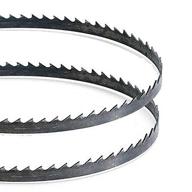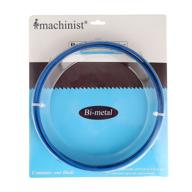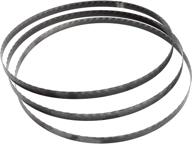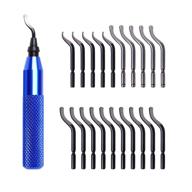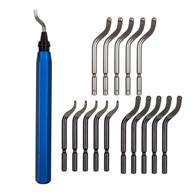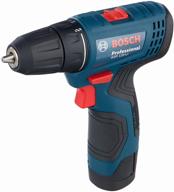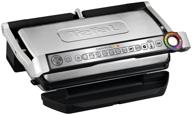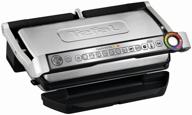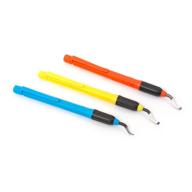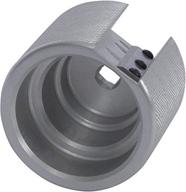Another interesting products
The Problems Caused by Burrs and How Deburring Cutters Solve Them
Burrs are small, raised edges or projections that are left behind after machining operations like milling, turning, drilling, and grinding. While burrs may seem harmless, they can actually cause a number of problems if not removed properly:
- Safety hazards - Burrs can cause cuts and scrapes for workers handling machined parts
- Dimension errors - Burrs add unwanted material that can interfere with proper fit and function
- Process issues - Burrs can break off and contaminate fluids or jam precision machinery
- Cosmetic defects - Burrs detract from the appearance of the final product
- Assembly problems - Burrs get in the way when trying to assemble machined components
Some common examples of real-world issues caused by burrs include:
- Burrs on hypodermic needles preventing proper mating with syringes
- Burrs on gears causing accelerated wear or jamming of transmission systems
- Sharp burrs on machined aluminum brackets scratching workers’ hands during handling
Fortunately, deburring cutters provide an efficient method for eliminating burrs and solving these problems. Deburring cutters use a sharpened blade to slice or scrape away the unwanted burr material. Here are some key benefits they offer:
- Clean, consistent burr removal without secondary operations like manual grinding or filing
- Ability to deburr internal and external edges in one operation
- Variety of cutter types for different applications - blades, wheels, mounted stones, etc.
- Automated deburring possible by mounting in CNC machines
- Relatively low cost and fast payback compared to manual deburring
By utilizing deburring cutters, manufacturers can avoid scrapped parts, increased processing time, and potential hazards caused by overlooked burrs. This results in lower machining costs and improved quality control. Workers also benefit from a safer working environment. With so many advantages, it's easy to see why deburring cutters have become an indispensable tool for modern machining operations.
Top products in 🔪 Deburring Cutters
Types of Deburring Cutters
There are several major types of deburring cutters, each designed to remove burrs and sharp edges from different types of machined parts:
Similar products
Chamfer Cutters
Chamfer cutters have a beveled cutting edge and are used to chamfer or bevel the corner edges of machined parts. Some key advantages include:
- Creates smooth, angled edge instead of sharp 90 degree corner
- Reduces stress concentration and risk of crack initiation
- Allows parts to be easily assembled - no sharp corners to interfere
Chamfer cutters are commonly used on parts like gears, sprockets, bearings, and pulleys.
Corner Radius Cutters
Corner radius cutters put a rounded radius on part edges. Benefits include:
- Increases strength by reducing stress concentration
- Eliminates sharp corners than can scrape or cut
- Improves part appearance and feel in hand
These are useful on consumer products and medical components.
Blade Deburring Tools
Blade deburring tools use a small razor blade to slice off burrs. They allow:
- Targeted, precision deburring of problem areas
- Deburring of complex shapes and internal surfaces
- Can be performed manually or by robot
Blade deburring is ideal for intricate parts like hydraulic valves and aluminum castings.
In addition to these major categories, there are also abrasive wheels and brushes for high speed deburring along with mounted stones and files for manual finishing. With such a wide variety, manufacturers can find the perfect deburring cutters to meet their specific application requirements.
Choosing the Right Deburring Cutter
Selecting the optimal deburring cutter depends on several factors:
Type of Material Being Machined
The workpiece material affects cutter selection. For example:
- Diamond cutters for hardened steels and carbides
- Silicon carbide for cast iron
- Aluminum oxide for non-ferrous metals
Using the wrong cutter material can lead to rapid wear or chatter during cutting.
Size of Burr
Larger burrs require more aggressive deburring. Options include:
- Coarse grit cutters for heavy burrs
- Ceramic grain cutters for large burrs on precision components
- Finishing cutters for light burrs
Starting with a coarse cutter prevents premature wear when deburring parts with substantial burrs.
Required Precision
Tighter tolerance parts need finer deburring control:
- Close tolerance deburring on precision gears, pumps
- Light finish cuts after initial deburring
- Use rigid setups to minimize deflection
This prevents over-deburring and maintains critical dimensions.
Location of Burrs
Burr location determines the cutter type. For example:
- Rotary files for internal passages
- Interchangeable heads for bores
- Flap wheels for end surfaces
Having the right cutter reach is crucial for accessing confined areas with burrs.
By considering these key factors, processors can select deburring cutters that allow efficient, quality burr removal tailored to their specific application.
Proper Use of Deburring Cutters
To safely and effectively use deburring cutters, follow these guidelines for speeds, feeds, depths of cut, and order of operations:
Speeds and Feeds
- Follow manufacturer recommendations for optimal cutter RPM
- Use lower speeds for harder materials and intermittently contact deburring
- Higher speeds work for high volume continuous cutting of soft metals
- Set feed rates based on workpiece material, cutter diameter and desired finish
- Gradually engage cutter - don't just plunge in!
Depths of Cut
- Light depths of cut avoid cutter overload
- Roughing cuts up to 0.5mm deep for initial burr removal
- Finishing cuts less than 0.1mm for final smoothing
- Allow chip clearance to prevent re-cutting
Order of Operations
- Rough deburring early before finishes and coatings are applied
- Deburr accessible external surfaces first
- Use extensions and specialty tools for internal deburring
- Always finish with a light pass for final surface polish
Other Tips
- Secure part with proper fixturing to prevent vibration
- Use appropriate guarding and PPE during operation
- Frequently clear chips to prevent cutter clogging
- Allow new cutters a break-in period for best performance
By adopting best practices for deburring cutter use, manufacturers can achieve uniform burr removal while maximizing cutter life and operational safety.
Deburring Cutter Maintenance
Proper maintenance is crucial for deburring cutter longevity and performance. Key aspects include:
Cleaning
- Remove built-up chips and debris regularly
- Clean cutters after each use to prevent rusting
- Blow off dust using compressed air
- Protect cutters from liquids which can wash away lubricants
Storage
- Keep cutters in a clean, dry space
- Store cutters vertically in racks to avoid damage
- Don't stack or throw cutters haphazardly in drawers
- Use protective cases for indexed cutters and replaceable heads
Sharpening
- Follow manufacturer sharpening specs for grit size, wheel speed, etc.
- Diamond dress wheels to prevent glazing
- Use cutting fluids and coolants during sharpening
- Don't overheat cutters - allow cooling between passes
Replacement
- Monitor cutting edges for wear and chipping
- Rotate indexable cutters to expose fresh edges
- Replace cutters once all edges are worn
- Change cutters used on abrasive materials more frequently
Other vital maintenance steps include:
- Lubricating cutter arbors and shafts
- Re-tightening any loose setscrews or connections
- Checking runout and tram for uneven wear
With proper maintenance habits, deburring cutters can deliver consistent, optimum performance and maximize operational uptime.
Using Amazon Prime for Deburring Cutter Purchases
For manufacturers or machinists who frequently purchase deburring cutters, an Amazon Prime membership can provide several advantages:
Free Two-Day Shipping
Amazon Prime offers free two-day shipping on hundreds of thousands of items, including most deburring cutters. This allows you to get new or replacement cutters faster without paying extra shipping fees each time.
Prime Early Access
During peak sales events like Prime Day, Amazon Prime members get 30-minute early access to some of the best deals. This creates opportunities to save big when stocking up on cutters.
Free Returns
Amazon Prime includes free returns on most marketplace items. If you ever need to return a defective or incorrectly shipped deburring cutter, you can send it back at no cost.
Amazon Business Pricing
If purchasing for a business, joining Amazon Business allows Prime members to get exclusive discounts and pricing on many supplies, including deburring cutters.
Whole Foods Discounts
Amazon Prime members get an extra 10% off sale items at Whole Foods stores. The savings from grocery discounts can help offset the $139 annual Prime membership fee.
For avid deburring cutter buyers, the time and money savings realized from Amazon Prime perks like free shipping and returns can easily justify the membership cost. Plus, the other Prime benefits like video/music streaming and photo storage make the subscription worthwhile for both personal and business use.
Deburring Tool PVC
Deburring tools are essential for removing burrs and sharp edges from PVC pipes after cutting, drilling, or milling tasks. Here are some popular deburring tools for PVC pipes:
- AFA Tooling Deburring Tool with 11 High-Speed Steel Blades - This tool works on metal, resin, PVC pipes, copper, plastic, and 3D printed edges, making it suitable for industrial professionals, machinists, and DIYers alike. It comes with 11 high-speed steel blades that are highly durable and can be replaced easily.
- RIDGID 1/2 in. to 1-1/2 in. Plastic PVC Pipe and Tubing Deburring Tool - This tool is ideal for removing outside ridges and inside burrs on plastic pipe and tubing. It is made of high-grade steel with specially-designed blades that provide fast, clean, and easy deburring.
- Reed Tool DEB2 Deburring Tools for Plastic Pipe up to 2" - This tool is suitable for PVC, CPVC, PE, ABS, and PP pipes. It has a nominal pipe capacity of up to 2 inches and is designed to remove burrs and sharp edges quickly and easily.
- DB1000 Double Edge Cutting Deburring Tool - This is a double-edge cutting tool that offers comparatively faster results with the same accuracy and precision. It can remove burrs from both sides in a single pass for materials like sheet metal. The blade and mounting design of this tool is quite different compared to other options.
- VASTOOLS Deburring Tool - This is a 61⁄2 inches diameter deburring tool that will work swiftly on a variety of metals such as aluminum, copper, brass, and plastic pipes. You can easily remove burrs from any of these materials thanks to the large handle size of the tool.
- Drainage Solutions DEB3 Deburring Tool - This tool features a long-lasting, hardened tool steel, deburring blade. It is designed to remove burrs and sharp edges from PVC pipes quickly and easily.
- YouTube video tutorial - There are many video tutorials available on YouTube that demonstrate how to deburr PVC pipes. One such video shows how to easily deburr PVC pipes using sandpaper or a deburring tool.
Overall, deburring tools for PVC pipes are designed to remove burrs and sharp edges quickly and easily, resulting in better mock-ups and glue joints.






